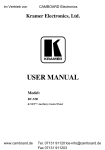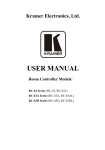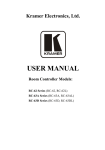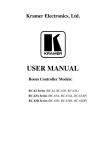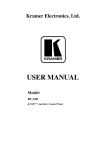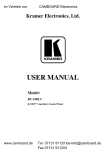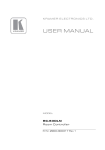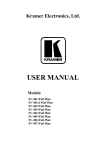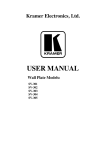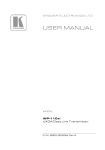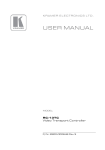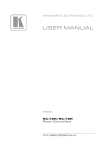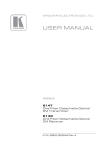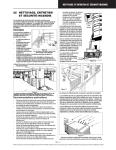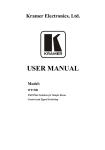Download Rc 53dlc
Transcript
K R A ME R E LE CT R O N IC S L TD . USER MANUAL MODEL: RC-53DLC K-NET™ Auxiliary Control Panel P/N: 2900-000752 Rev 4 Contents 1 Introduction 1 2 2.1 2.2 2.3 3 3.1 3.2 Getting Started Achieving the Best Performance Safety Instructions Recycling Kramer Products Overview Defining the RC-53DLC K-NET™ Auxiliary Control Panel Grounding the RC-53DLC 2 2 3 3 4 4 9 4 Using the RC-53DLC 10 5 Installing the RC-53DLC Faceplate, Button Caps and Labels 12 6 Operating the RC-53DLC 14 7 Technical Specifications 15 Figures Figure 1: RC-53DLC US Version – Front Panel Figure 2: RC-53DLC US Version – Rear Panel Figure 3: RC-53DLC European Version – Front Panel Figure 4: RC-53DLC European Version– Rear Panel Figure 5: Grounding Connection Components Figure 6: RC-53DLC Connected to the SV-551 SummitView™ Processor/Switcher Figure 7: Sample Button Label Sheet Figure 8: Button Cap Orientation Figure 9: Inserting the Label Figure 10: Placing the Button Cap Figure 11: RC-53DLC Label Setup 5 6 7 8 9 11 12 12 13 13 14 RC-53DLC – Contents i 1 Introduction Welcome to Kramer Electronics! Since 1981, Kramer Electronics has been providing a world of unique, creative, and affordable solutions to the vast range of problems that confront video, audio, presentation, and broadcasting professionals on a daily basis. In recent years, we have redesigned and upgraded most of our line, making the best even better! Our 1,000-plus different models now appear in 11 groups that are clearly defined by function: GROUP 1: Distribution Amplifiers; GROUP 2: Switchers and Routers; GROUP 3: Control Systems; GROUP 4: Format/Standards Converters; GROUP 5: Range Extenders and Repeaters; GROUP 6: Specialty AV Products; GROUP 7: Scan Converters and Scalers; GROUP 8: Cables and Connectors; GROUP 9: Room Connectivity; GROUP 10: Accessories and Rack Adapters and GROUP 11: Sierra Products. Congratulations on purchasing your Kramer RC-53DLC, which is available in European (80mm and 86mm height versions) and American versions, and can be used as a system controller when connected via K-NET™ to a Master room controller (for example, the SV-552 SummitView™ Processor / Switcher or one of the Kramer SL series controllers). RC-53DLC - Introduction 1 2 Getting Started We recommend that you: Unpack the equipment carefully and save the original box and packaging materials for possible future shipment Review the contents of this user manual i 2.1 Go to http://www.kramerelectronics.com/support/product_downloads.asp to check for up-to-date user manuals, application programs, and to check if firmware upgrades are available (where appropriate). Achieving the Best Performance To achieve the best performance: Use only good quality connection cables (we recommend Kramer highperformance, high-resolution cables) to avoid interference, deterioration in signal quality due to poor matching, and elevated noise levels (often associated with low quality cables) Do not secure the cables in tight bundles or roll the slack into tight coils Avoid interference from neighboring electrical appliances that may adversely influence signal quality Position your Kramer RC-53DLC away from moisture, excessive sunlight and dust ! 2 This equipment is to be used only inside a building. It may only be connected to other equipment that is installed inside a building. RC-53DLC - Getting Started 2.2 Safety Instructions ! 2.3 Caution: There are no operator serviceable parts inside the unit Warning: Use only the Kramer Electronics input power wall adapter that is provided with the unit Warning: Disconnect the power and unplug the unit from the wall before installing Recycling Kramer Products The Waste Electrical and Electronic Equipment (WEEE) Directive 2002/96/EC aims to reduce the amount of WEEE sent for disposal to landfill or incineration by requiring it to be collected and recycled. To comply with the WEEE Directive, Kramer Electronics has made arrangements with the European Advanced Recycling Network (EARN) and will cover any costs of treatment, recycling and recovery of waste Kramer Electronics branded equipment on arrival at the EARN facility. For details of Kramer’s recycling arrangements in your particular country go to our recycling pages at http://www.kramerelectronics.com/support/recycling/. RC-53DLC - Getting Started 3 3 Overview The RC-53DLC is an auxiliary remote control panel for Master Room Controllers (such as the Kramer SummitView System or the SL-1 Master Room Controller) for controlling AV equipment in a room. The RC-53DLC features: Six front panel, backlit buttons designed in two groups; one group of two buttons, and another group of four buttons 256 colors are available for backlit buttons (to be configured by the system integrator). The colors of each button can be programmed with flexible RGB values. 3.1 A digital volume control adjustment knob A 2 gang wall plate for the USA and for Europe K-NET operation - does not require a separate power supply An RS-232 serial port Two K-NET ports and a USB port for firmware upgrade Two programmable LCD displays, one for each button group Defining the RC-53DLC K-NET™ Auxiliary Control Panel This section defines the RC-53DLC US (see Section 3.1.1) and European (see Section 3.1.2) versions. 4 RC-53DLC - Overview 3.1.1 RC-53DLC for the US Figure 1 defines the RC-53DLC US front panel. Figure 1: RC-53DLC US Version – Front Panel # Feature Function 1 SOURCE Buttons Group of four programmable (by the system integrator only), backlit buttons 2 Faceplate Screws Four screws connecting the faceplate to the Rear Box 3 “DISPLAY” and “SOURCE” Labels Programmable, 8 character, LCD displays on a blue background Remove the protective transparent film from both LCD displays before mounting the faceplate 4 DISPLAY Buttons Group of two programmable, backlit buttons 5 Maximum VOLUME LED Lights red, indicating maximum volume 6 VOLUME LEDs Light green, indicating volume level 7 VOLUME Knob Rotate clockwise to increase volume level 8 K-NET TERM Switch Slide downwards (in the direction of the arrow) for K-NET termination, slide upwards to leave bus un-terminated. The last physical device on a K-NET bus must be terminated You can access the switch by removing the volume control knob, and unscrewing the 4 screws on the front panel RC-53DLC - Overview 5 Figure 2 defines the RC-53DLC US rear panel. Figure 2: RC-53DLC US Version – Rear Panel # 1 Feature Program USB Connector Function Connect to a computer for firmware upgrade When the unit is connected via K-NET to a Master Room Controller, you can upgrade the firmware via the USB or ETH ports of the Master Room Controller 2 Grounding Screw 3 RS-232 Terminal Block Connect to grounding wire (see Section 3.2) For factory use only 4 K-NET Terminal Block 5 K-NET Terminal Block Connect the GND to the ground connection, connect B (-) and A (+) to RS-485, and connect +12V to +12V on the companion unit The ground connection is sometimes connected to the shield of the RS-485 cable (in most applications, it is not connected) 6 6 PROG Switch For technical support use only (should be set to the left in the direction of the arrow for normal operation) RC-53DLC - Overview 3.1.2 RC-53DLC for Europe Figure 3 defines the RC-53DLC front panel for the European version. Figure 3: RC-53DLC European Version – Front Panel # Feature Function 1 SOURCE Buttons Group of four programmable, backlit buttons (by the system integrator only) 2 Faceplate Screws Four screws connecting the faceplate to the Rear Box 3 “DISPLAY” and “SOURCE” Labels Programmable, 8 character, LCD displays on a blue background Remove the protective transparent film from both LCD displays before mounting the faceplate 4 DISPLAY Buttons Group of two programmable, backlit buttons 5 Maximum VOLUME LED Lights red, indicating maximum volume 6 VOLUME LEDs Light green, indicating volume level 7 VOLUME Knob Rotate clockwise to increase volume level RC-53DLC - Overview 7 Figure 4 defines the RC-53DLC rear panel for the European version. Figure 4: RC-53DLC European Version– Rear Panel # 1 Feature Program USB Connector Function Connect to a computer for firmware upgrade When the unit is connected via K-NET to a Master Room Controller, you can upgrade the firmware via the USB or ETH ports of the Master Room Controller 2 Grounding Screw 3 RS-232 Terminal Block Connect to grounding wire (see Section 3.2) For factory use only 4 K-NET Terminal Block 5 K-NET Terminal Block Connect the GND to the Ground connection, connect B (-) and A (+) to RS-485, and connect +12V to +12V on the companion unit The ground connection is sometimes connected to the shield of the RS-485 cable (in most applications, it is not connected) 6 PROG Switch For technical support use only (should be set to the right in the direction of the arrow for normal operation) 7 K-NET TERM Switch Slide downwards (in the direction of the arrow) for K-NET termination, slide upwards to leave bus unterminated. The last physical device on a K-NET bus must be terminated You can reach the KNET termination switch by inserting a small screwdriver into the gap between the rear panel PCB and the metal rear panel cover. 8 RC-53DLC - Overview 3.2 Grounding the RC-53DLC The grounding screw is used to earth the chassis of the unit to the building ground preventing static electricity from impacting the performance of the unit. Figure 5 defines the grounding screw components. # Component Description 1 M3X6 screw 2 1/8" Toothed Lock Washer 3 M3 Ring Tongue Terminal Figure 5: Grounding Connection Components To ground the RC-53DLC: 1. Connect the ring tongue terminal to the building grounding point wire (it is recommended to use a green-yellow AWG#18 (0.82mm2) wire, crimped with a proper hand-tool). 2. Insert the M3x6 screw through the toothed lock washers and the tongue terminal in the order shown above. 3. Insert the M3x6 screw (with the two toothed lock washers and ring tongue terminal) into the grounding screw hole and tighten the screw. RC-53DLC - Overview 9 4 Using the RC-53DLC i Always switch off the power to each device before connecting it to your RC-53DLC. After connecting your RC-53DLC, connect its power and then switch on the power to each device. The installation process is not detailed in this user manual. This user manual is applicable once the unit is installed and configured (by authorized Kramer technical personnel or by an external system integrator), and includes: Setting up the labels on the buttons, according to your specific requirements Configuration of the master room controller via the K-Config Windows®based configuration software Since the auxiliary panel is used as a remote controller for Master Room Controllers via the proprietary communication channel K-NET (as illustrated in Figure 6): It requires only a K-NET connection to the master room controller A power supply unit is not required If needed, power supplies are sold separately. Consult your Kramer dealer for details. The auxiliary panel can be programmed only via the Master Room controller (for example, the Kramer SV-551 SummitView™ Processor/Switcher) 10 RC-53DLC - Using the RC-53DLC Figure 6: RC-53DLC Connected to the SV-551 SummitView™ Processor/Switcher RC-53DLC - Using the RC-53DLC 11 5 Installing the RC-53DLC Faceplate, Button Caps and Labels This section describes how to install the faceplate, button caps and labels. Figure 7 illustrates a sample button label sheet. Figure 7: Sample Button Label Sheet To install the faceplate, button caps and labels: 1. Remove the required labels from the supplied button label sheet. 2. Hold the button cap so that it is oriented as shown in Figure 8 with the “wings” on the left and right sides. Figure 8: Button Cap Orientation 12 RC-53DLC - Installing the RC-53DLC Faceplate, Button Caps and Labels 3. Insert the label inside the cap ON Figure 9: Inserting the Label 4. Repeat for all six caps. 5. Retaining the orientation, place the six button caps on the buttons of the RC-53DLC. Figure 10: Placing the Button Cap 6. Remove the protective foils from both sides of the Perspex (acrylic glass) windows. 7. Remove the protective foils from both displays. 8. Place the faceplate on the RC-53DLC so that the four screw mounting holes are aligned. 9. Insert the four mounting screws and tighten with a screwdriver. 10. Install the volume control knob. RC-53DLC - Installing the RC-53DLC Faceplate, Button Caps and Labels 13 6 Operating the RC-53DLC In the following example (illustrated in Figure 11), the auxiliary control panel is labeled with specific functions and each button is programmed by the technical installer to perform several tasks (a macro sequence, including several commands per button, carried out one after the other) as defined in the table below. This is only one example among numerous possibilities, each button can be programmed as required. In this example, two buttons are not assigned. Label ON Power up the projector Power up the DVD player The DVD button turns blue Roll down the projector screen 1 minute delay (for the projector to heat up) The projector selects the DVD input OFF Power down the projector Stop the DVD player The DVD button turns red Power down the DVD player Stop the VCR The VCR button turns red Power down the VCR Roll up the projector screen DVD Stop the video player The VCR button turns red The projector selects the DVD input The DVD button color turns orange Play the DVD 5 second delay The DVD button color turns green VCR Stop the DVD The DVD button turns red The projector selects the VCR input The VCR button color turns orange Play the VCR 5 second delay The VCR button color turns green VOLUME Use the VOLUME knob to adjust the audio level Figure 11: RC-53DLC Label Setup 14 Macro Sequence RC-53DLC - Operating the RC-53DLC 7 Technical Specifications PORTS: 2 K-NET on terminal block connectors; 1USB connector, 1 RS-232 on terminal block connector (factory use only) FUSE: 500mA, FSMD 1812 POWER CONSUMPTION: 12V DC, 140mA over K-NET OPERATING TEMPERATURE: 0° to +40°C (32° to 104°F) STORAGE TEMPERATURE: -40° to +70°C (-40° to 158°F) HUMIDITY: 10% to 90%, RHL non-condensing DIMENSIONS: For the USA: 11.4cm x 2.6cm x 11.4cm (4.49" x 1.02" x 4.49", W, D, H) For Europe: 15.2cm x 1.9cm x 8.6cm (5.98" x 0.75" x 3.39", W, D, H) or 15.2cm x 1.9cm x 8cm (5.98" x 0.75" x 3.15", W, D, H) WEIGHT: 0.14kg (0.31lbs.) approx. INCLUDED ACCESSORIES: Screwdriver Specifications are subject to change without notice at http://www.kramerelectronics.com RC-53DLC - Technical Specifications 15 For the latest information on our products and a list of Kramer distributors, visit our Web site where updates to this user manual may be found. We welcome your questions, comments, and feedback. Web site: www.kramerelectronics.com E-mail: [email protected] ! P/N: SAFETY WARNING Disconnect the unit from the power supply before opening and servicing 2900- 000752 Rev: 4




















